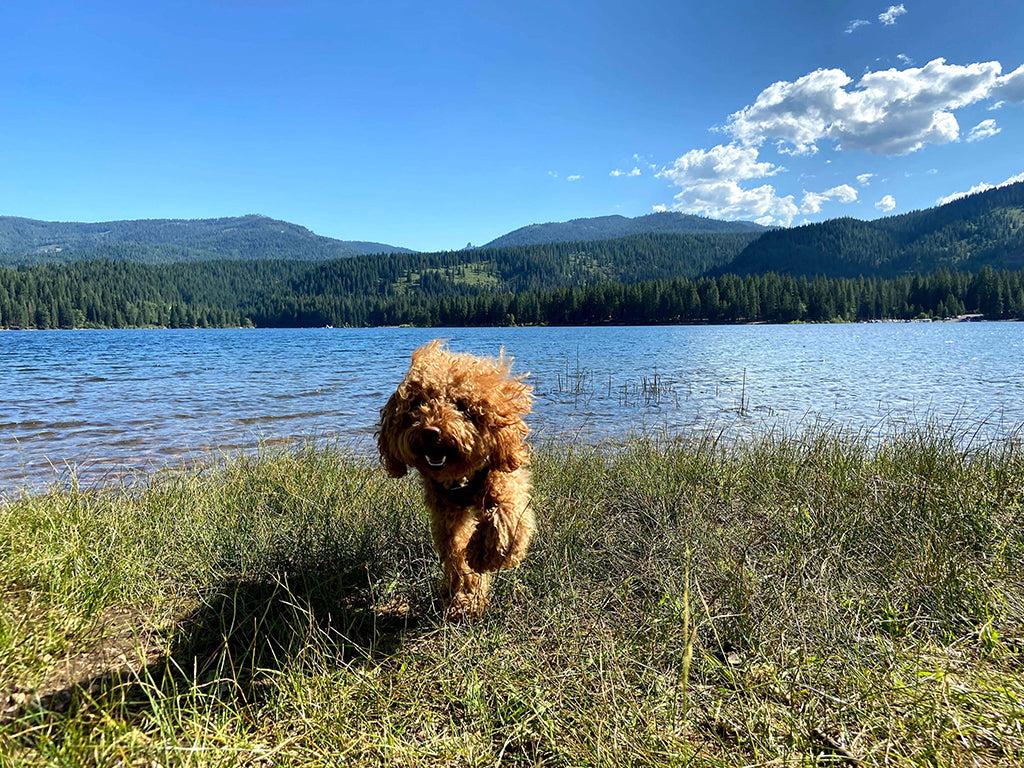Learn all about blue-green algae and why it poses such a threat to the welfare of our dogs. We’ll discover what blue-green algae is, the symptoms of poisoning to look out for, and the treatment for blue-green algae poisoning in dogs.
- Home/
- Dog/
- Health & Wellness/
- Blue Green Algae & Dogs
Blue Green Algae & Dogs

What Is Blue-Green Algae?
Frustratingly and confusingly, blue-green algae aren’t actually algae! Blue-green algae are bacteria, scientifically known as cyanobacteria.
So, why are they called blue-green algae? Because they look just like algae when they’re clumped together in bodies of water like lakes, streams, and ponds.
Blue-green algae can also occur in birdbaths and pots in your yard. You can’t see blue-green algae with your naked eyes unless it’s clumped like this either.
It’s more commonly seen during the hotter, drier summer months when it rains less and in water that doesn’t have much of a flow. It usually blooms and thrives in water that reaches over 75°F.
Blue-green algae look like a blue-green clump of flakes or bundles on the surface of the water and is usually near the edges. Some describe its appearance as similar to soup or paint. You may also spot dead fish if you’re at a body of water that’s been infected with blue-green algae.
Remember though, blue-green algae may be present even if you can’t see it.

Blue-Green Algae & Dogs
Not all types, but many variations of blue-green algae can be incredibly toxic to dogs. It can stop their liver from functioning and often results in the loss of a dog’s life. Some types of bacteria can kill a pup within an hour, and some as fast as 15 minutes.
Pups can be contaminated by drinking infected water or getting the algae caught in their fur whilst swimming and licking it off later.
If you’re near a body of water that looks infected or poses any sort of risk of being contaminated with blue-green algae, it’s best to not let your dog near it at all and certainly don’t let them drink from it. Many local authorities will put signs up if they are aware of infected water, so look out for these on your walks too.
If your dog does jump in the water, make sure you clean them thoroughly before they get a chance to try themselves.
Blue-Green Algae Dogs Symptoms
If your dog has swum, paddled, or drunk from water potentially infected with blue-green algae and starts presenting any of the following symptoms:
- Noticeably drooling
- Difficulty breathing
- Weakness
- Collapse
- Confusion
- Unconsciousness
- Jaundice (turning yellow)
- Seizures
- Excessive tearing
- Pale gums
- Vomiting
- Diarrhea
Contact their vet immediately and tell them. They should request you get your dog to them as soon as possible.

There is no antidote to blue-green algae, but your vet should attempt to flush their body of the bacteria via induced vomiting, fluids or they may use oral activated charcoal to help absorb the toxins. They could also have their stomach pumped.
These symptoms are similar to other illnesses too, but only a vet will be able to determine the exact cause of them. If your dog is seeming unwell, they should always be seen by a vet.
PetLab Co. Pro Tip: Blue-green algae is also toxic to cats, so if you’re a cat owner and live near a lake, stream, or pond that is infected, contact your vet immediately if you expect they’ve ingested contaminated water.
Can Humans Be Affected?
Yes, blue-green algae can cause severe illness in humans too. Symptoms can include vomiting, rashes, stomach pain, headaches, and fever. Liver and brain damage has been attributed to a blue-green algae infection in some cases before too.
It’s wise not to drink or enter risky water, and note that children are more vulnerable to blue-green algae poisoning than adults.
If you spot what you suspect is blue-green algae in a local pond, stream, or lake but don’t see a sign, it is worth getting in contact with your local authorities/environmental agencies to let them know. This will help protect other pets and people in your community.
Sources
“Blue-Green Algae And It’s Danger To Dogs” Jul 19. 2018, Blue Cross https://www.bluecross.org.uk/pet-advice/blue-green-algae-and-its-dangers-dogs
Author Taffer, Marissa “What To Know About Blue-Green Algae Poisoning In Dogs” Aug 31. 2021, Dog-Eared https://blog.myollie.com/blue-green-algae-and-dogs/
 S
S



